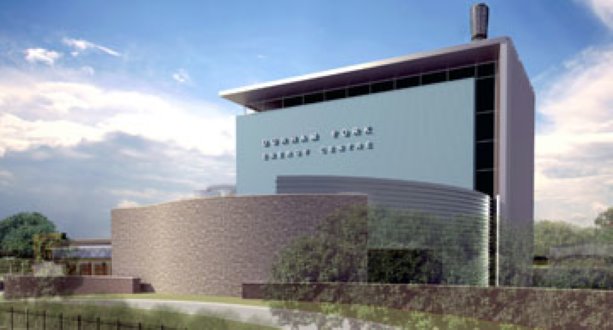Durham York Energy Centre in the Clarington Energy Park east of Toronto is expected to burn up to 140,000 tonnes of post-diversion garbage annually. A general contractor will soon be selected for the centre, designed by Toronto-based McMillan Associates Architects. Covanta Energy will design, build and operate the centre.
Construction of a $272-million state-of-the-art energy-from-waste incineration facility is expected to get underway shortly following the recent ground breaking for the Durham York Energy Centre in the Clarington Energy Park in Clarington.
The facility is expected to burn up to 140,000 tonnes of post-diversion garbage annually. Covanta Energy will design/build and operate the energy-from-waste (EFW) centre under a 20-concession agreement with Durham and York Regions. The New-Jersey-based firm was one of four pre-qualified vendors that bid on the project, located about 70 kilometres northeast of downtown Toronto.
Designed by Toronto-based McMillan Associates Architects, the steel, concrete and metal building will include a visitors’ centre which will showcase waste diversion systems.
The two regions are heralding the centre as a long-term sustainable solution to manage the solid waste remaining after diversion (reuse, reduction, recycling and composting) and to minimize the amount of waste that has to go to landfill sites.
As the centre will be processing approximately 110,000 tonnes of garbage generated in Durham, that region will be paying 78 per cent of the cost, with York picking up the balance based on its 30,000 — tonnes yearly allocation. The regions are using federal gas tax funding to finance the project.
A general contractor will soon be selected and the facility will be completed and operational by the end of 2014, says Covanta senior vice president Mathew Mulcahy. “Based on our experience with other projects we believe that 600 direct and indirect construction jobs will be created.”
Just some of the material which will be consumed in the construction includes 7,500 cubic metres of concrete, 1,100 metric tons of structural steel and 10, 200 square metres of metal siding, says Mulcahy.
Some of the equipment and machinery will be pre-purchased by Covanta. In other cases it will be the responsibility of the contractor. Although it will be sized to accommodate long-term future operating demands any physical expansion of the facility will be a decision made by the regions, he says.
A thermal mass technology where solid waste is fed into a furnace and burned at temperatures above 1,000 degrees Celsius will be used. The remaining ash will then either be shipped to landfill sites or reused in product manufacturing.
The process also includes the production of high-pressure steam which will be fed through a generator to produce electricity.
“It will be self-sustaining,” says Mulcahy, who estimates that 17.5 of the 20 megawatts generated will be fed into the provincial grid. The steam will be used for a future district heating system for the Clarington Park.
According to regional officials, air emissions from the centre will be subject to some of the most stringent levels in North America.
Still that didn’t deter a number of anti-incinerator demonstrators at the ground breaking ceremony. Their suggestions the centre would contribute to air pollution were dismissed by Durham Region Chair Roger Anderson.
“This (the centre) will be the best of the best. If we were opening a landfill site there would be protests against that as well,” said Anderson in a short interview after the opening.
It was Durham’s decision, made in 1999, that there would be no new landfill sites in the region which ultimately led to the EFW. A key objective of that policy was to investigate technically feasible methods to reduce garbage “that could be achieved in an environmentally and financially responsible manner.”
That was the beginning of a long planning and consultative process, including a consultant study which recommended the thermal treatment option. The recommendation was approved by the two regions in 2006. Public opinion polls also showed that a majority of residents agreed supported the building of the facility as opposed to the continued use of landfills, says Anderson.











Recent Comments
comments for this post are closed